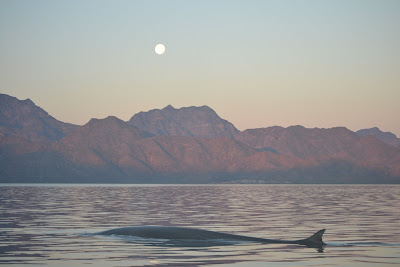
Throughout the week, we were blessed with good weather, still waters, a breathtaking full moon, and many close encounters with whales. Always eager to get an early start, we were out on the water before sunrise, where we were able to behold the magical transition of night into day.

Here's the oasis town of Loreto in the early-morning sun.

We would pause in the middle of the bay, turn the motor off, and enjoy the sunrise as we looked and listened for the breathing of the whales.

When the light was just right, their spouts would glow.

To the west, we could see the full moon set over the mountains. Michael arranged the boat perfectly for this shot of a fin whale with this amazing backdrop.

We saw a total of 4 kinds of baylene whales while we were on the Sea of Cortez: blue whales, fin whales, humpback whales, and bryde's whales (pronounced "brude-ess"). By far, we saw more blues and fins than any other kind, and Michael taught us how to tell the difference between these whales.
The finbacks are the fastest whales, and they are a dark, nearly black color with a relatively large dorsal fin. They also never "fluke", or bring their tails out of the water. Here's a few photos of fin whales.




Blue whales are the Earth's largest creatures. The individuals are identifiable by the pigmentation on their backs, which can vary greatly as you can see in the following photos.


Blue whales will occasionally fluke, and we were lucky enough to follow a very mellow "fluker" blue whale the last day we were on the water. She was actually quite a ham; twice she surfaced right beside our boat, took a few breaths, dove, fluked, and pooped right in front of us. (She was a logger, fluker, pooper!) Here she is surfacing right by our boat.

And look at this amazing fluke sequence that Michael captured.






Even though blue whales and fin whales are different species, they have been known to mate and produce young. Michael told us that there are 4 known individuals which are genetic crosses of blue and fin whales. There may be a 5th individual this time next year in the Sea of Cortez. We came upon a finback, presumably a male, who was following a blue whale who we assumed to be female. At one point, the leading blue whale got excited and "head-lunged" out of the water and started speed-swimming. The finback was right on her tail, and he would dive only after she dove. We came upon these lovebirds three times, on three different days. It was the week of Valentine's Day, and love was in the air (or shall we say, the water).
Here's the frisky finback who likes big blues. He has a very unique dorsal fin.

And here's the blue whale, reflecting the early morning light off her back and dorsal fin.

I was able to get a little video of this pair. The leading whale is the blue whale, and the fin whale is following her. Notice that you can only hear the exhalation of the blue whale, but when the finback breathes, you can hear his exhalation and a wheezing inhalation. This is another way to differentiate the two species. This also gives you an idea of how incredibly peaceful our time on the water was.
Because the water was so clear and still, when the sun was over-head and a whale was just under the surface of the water, we were able to see its entire massive form. It was a staggering experience, and I nearly fell over every time I saw how huge these whales actually are. Blue whales are not only the biggest animals alive today, they are the biggest animals ever known to exist - way bigger than dinosaurs! Michael put it in perspective when he compared the size of a blue whale to 4 school buses parked 2 behind 2. Here's the head of a blue whale; we estimate this part of the whale to be about 20 feet of it's total length, which averages about 80 -100 feet long.

Whales are not the only sea mammals we enjoyed seeing this week. We had several opportunities to see both common dolphins and bottle-nosed dolphins as they would join us to "bough-ride" our boat.


We even saw a couple of dolphins "bough-ride" this blue whale. What fun!

Here are some common dolphins with a spouting blue whale in the distance.

And let's not forget the California Sea Lions.


All this amazing wildlife, beautiful scenery, time with friends, and lots of delicious food made for some very happy gringos.






No comments:
Post a Comment